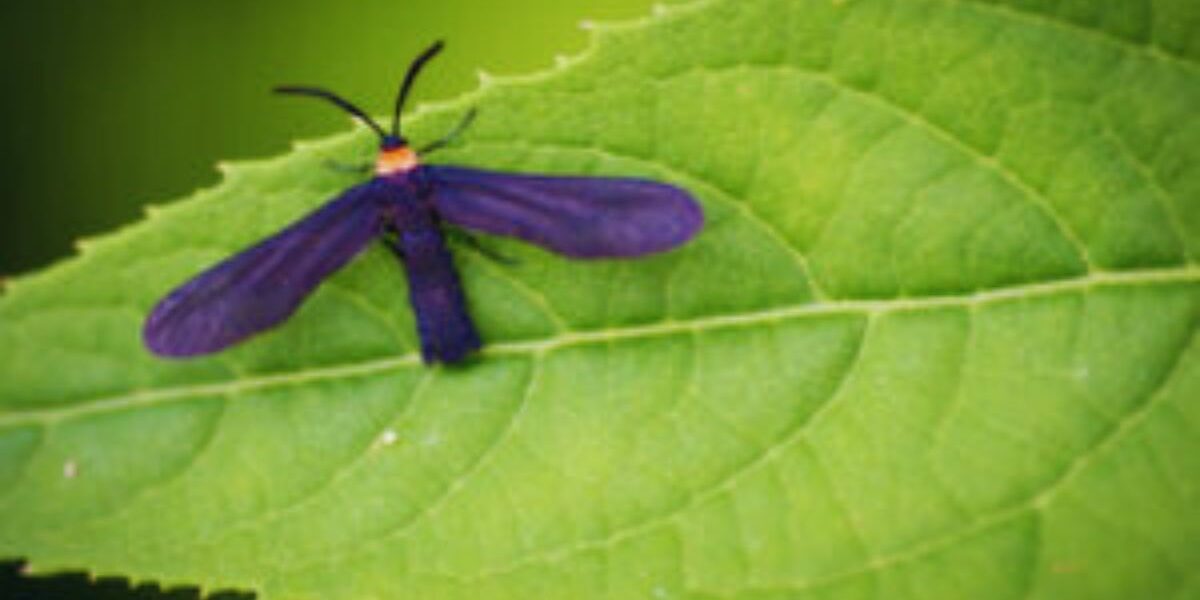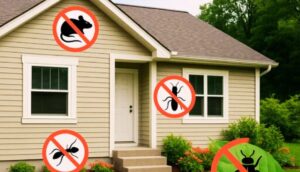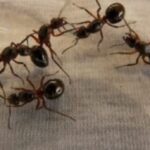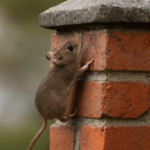How to Control Grapeleaf Skeletonizer
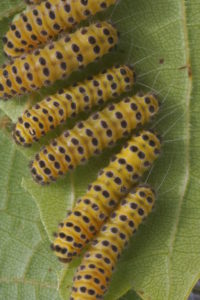
The term leaf skeletonizer refers to the leaves of certain species of garden plants including the grape plant that are damaged by the larvae of the grapleaf moth. The adult moth lays her eggs on the underside of the plant leaves in a cluster.
Once the eggs hatch the larvae start feeding on the leaves. These larvae are heavy feeders or have a huge appetite, this is the reason for such destruction. The lifecycle of the grapeleaf larvae moth includes five stages. With each stage, the larvae grow larger.
Plants manufacture their food by photosynthesis, which is made possible by the plant leaves that contain chlorophyll, because of the leaves being skeletonized the plant is unable to produce its food when this happens garden plant goes under further stress which puts the entire plant in danger of dying. Leaf skeletonizer is when the leaves of garden plants are so damaged there is nothing left except the rib structure or skeleton.
The Grapeleaf Skeletinizer Moth Identification
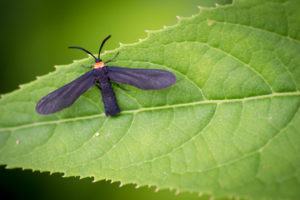
The adult grapeleaf skeletonizer moth wings are completely black and are typically held flat away from their bodies, a collar of red to orange is located behind their heads. Both the male and the female possess antennae that have the appearance of a comb or comblike. However the male antennae are feathery, the tips of their abdomens curl upwards and are expanded that end with a fanlike, two-parted tuft.
Grapeleaf Skeletonizer Larvae Identification
The grapeleaf skeletonizer larvae are yellowish with black spots or bands, on reaching maturity they are slightly more than 1/2 inch long. The eggs are capsule-shaped or cylindrical-oval and lemon yellow, slightly over 1/2 mm in length, and laid in clusters on the lower leaf surfaces.
Cultural Practices
- Proper cultural practice is a great way to lessen the chance of your garden plants falling prey to this issue and if your garden plants should fall prey these practices along with proper treatment will help your plant to bounce back. Meeting the full requirements of your garden plant’s needs is so important. These requirements include.
- Proper location of your garden plant as far as light requirements are concerned.
- The right soil type.
- Give your garden plants the right amount of water.
- Place your plants on a fertilizer program and follow the directions that are found on the manufacturer’s label.
Mechanical Control
Mechanical control is an effective method of control to implement in the war against these insects. Handpick larvae during the night hours, a flashlight is handy and will make your job easier. Placing the larvae in a container of soapy water will eliminate them.
Chemical Control
Chemical control involves the use of chemicals such as insecticidal soap sprays, organics, and other pesticides, reading the manufacturer’s label, and following the directions for the best results.
Biological Control
Biological control involves the use of good bugs such as ladybugs, praying mantis, mealybug destroyers, etc… to get rid of garden insect pests.
Dish soap Liquid and Water
Dish liquid and water are also effective in the control of the grapeleaf moth larvae, this simple yet safe solution will bring these larvae to a halt. Mix about 1 tablespoon of dish liquid soap to a 32 0z spray bottle. Thoroughly shake this solution and apply it to caterpillars and you’re done and in no time your grapeleaf moth larvae will be a thing of the past. Also, it will help to remove and discard infested leaves and plant material from the base of the vine and properly dispose of them. Infested plant material and leaves should not be added to your compost bin or used for composting.
Chemical Control
These listed Products will bring Control to the larvae stage, before applying read and follow the manufacturer’s directions for the best results.
- Bacillus thuringiense.
- Insectcidal soap spray.
- Horticultural grade oil.
- Neem oil.
- Bayer advanced vegetable and garden insect spray rts.
- Bayer advanced vegetable and garden insect spray
Controlling the Adult Moth
To control the adult moth here is what to use.
- PyGanic
- Spinosad
- Azadirachtin
- The use of Pheromone Traps during early spring can be used to lure the adults as they emerge and are in search of a mate.
10 Frequently Asked Questions (FAQs)
1. What is a Grapeleaf Skeletonizer Moth?
The Grapeleaf Skeletonizer Moth is a small, iridescent blue and yellow moth known for its caterpillars that feed on grapevine leaves. These larvae feed on the green parts of the leaf, leaving only the veins behind—hence the name “skeletonizer.”
2. Are Grapeleaf Skeletonizers harmful to my grapevines?
Yes, they can be! While the moth itself is harmless, the larvae can seriously damage grapevines by defoliating them. If left unchecked, a large infestation can weaken the vines and reduce grape yields.
3. How can I identify Grapeleaf Skeletonizer larvae?
Their caterpillars are hard to miss. They’re yellow with black bands and covered in tiny, stinging hairs. As they grow, their bodies darken, and they feed in large groups, creating visible damage on leaves.
4. Do Grapeleaf Skeletonizers sting?
Technically, they don’t sting like bees or wasps, but their tiny hairs can cause skin irritation or rashes if touched. It’s best to wear gloves when handling affected leaves or larvae.
5. When are Grapeleaf Skeletonizers most active?
These pests usually appear in late spring and continue breeding through summer into early fall. In warmer climates, they can go through multiple generations in a single season!
6. Can they kill my grapevines completely?
It’s unlikely they’ll kill mature vines outright, but repeated infestations over time can weaken the plant, make it more vulnerable to disease, and reduce fruit quality and quantity.
7. How can I control or get rid of them naturally?
You can handpick larvae, use neem oil, or spray Bacillus thuringiensis (Bt), an organic bacterial control that targets caterpillars without harming beneficial insects. Encouraging natural predators like birds and parasitic wasps can also help keep them in check.
8. Are there any chemical treatments that work?
Yes, insecticides like spinosad or permethrin can be effective, especially during the early larval stages. Be sure to follow label directions and only spray in the evening when pollinators aren’t active.
9. How do I prevent Grapeleaf Skeletonizers from returning next season?
Clean up fallen leaves and debris in fall to remove overwintering pupae. Prune your vines in winter and monitor early in the growing season for signs of larval activity so you can take action quickly.
10. Do they only affect grapevines?
Mostly, yes. Grapevines are their preferred host, but in some cases, they may also target Virginia creeper or other similar plants. If you have grapes growing nearby, those will likely be their first choice.
Conclusion
The grapeleaf larvae moth can destroy plant life, but with the right information you can take control, this guide is here to help you stop these pests in their tracks. You will be happy with the results as your plants grow beautiful and healthy providing you with a good harvest. Join the many who have put these methods to work and reap the benefits.

